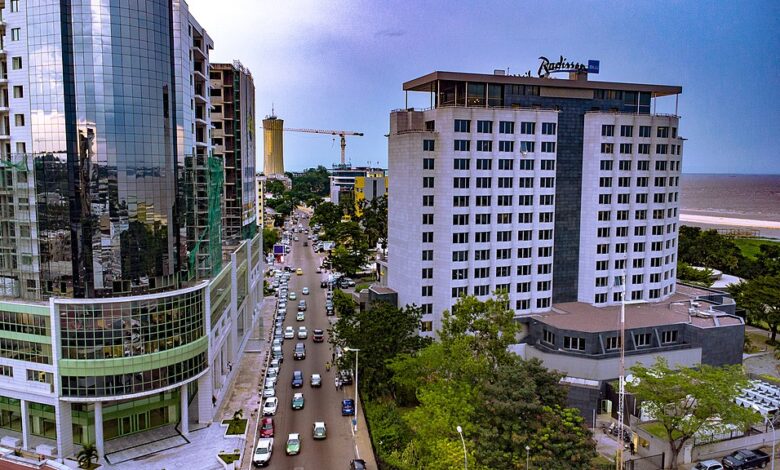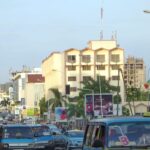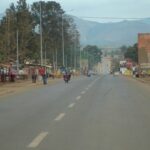Brazzaville

Brazzaville, situated on the north bank of the Congo River below Malebo (Stanley) Pool, is the capital city, commune, and river port of the Republic of Congo. It also served as the former capital of French Equatorial Africa. Established in 1883, Brazzaville began as the village of Ntamo, which was “purchased” by the French and transformed into a European administrative and residential hub.
Until the early 1960s, the city’s centre remained predominantly European, while African sections started developing in the northeast (Poto-Poto) and southwest (Bacongo and Makélékélé). Today, the administrative and commercial activities still revolve around the central city.
The river port of Brazzaville marks the endpoint of the Congo-Ocean transport system. It provides steamer services to the upper Congo River and connects to Pointe-Noire on the Atlantic coast via a railroad spanning 245 miles (394 km) to the west. Post-World War II, port facilities underwent significant expansion. Nearly half of the shipping activity is dedicated to transit trade for other Central African countries. Despite its extensive industrial and processing areas, Brazzaville’s primary function remains administrative.
The city boasts a Roman Catholic cathedral and hosts educational institutions such as a teachers’ training centre established in 1961, which later evolved into a national university in 1972. Students from Gabon, Chad, and the Central African Republic are drawn to Brazzaville for education. Additionally, vocational and technical institutes, the Poto-Poto School of African Art, and the regional headquarters of the World Health Organization contribute to the city’s educational and institutional landscape.
Map view
More about this city from Wikipedia
| ID |
|---|
| 17339 |
| Name |
| Brazzaville |
| State ID |
| 2870 |
| State Code |
| BZV |
| State Name |
| Brazzaville |
| Country ID |
| 50 |
| Country Code |
| CG |
| Country Name |
| Congo |
| Latitude |
| -4.26613000 |
| Longitude |
| 15.28318000 |
| WikiData ID |
| Q3844 |
Brazzaville (French pronunciation: [bʁazavil], Kongo: Ntamo, Ntambo, Kintamo, Kintambo, Tandala, Mavula; Teke: M'fa, Mfaa, Mfa, Mfoa) is the capital and largest city of the Republic of the Congo (Congo Republic). Administratively, it is a department and a commune. Constituting the financial and administrative centre of the country, it is located on the north side of the Congo River, opposite Kinshasa, the capital city of the Democratic Republic of the Congo (DR Congo).
The population of the capital is estimated to exceed 2.1 million residents, comprising more than a third of the national populace. Some 40% are employed in non-agricultural professions. During World War II, Brazzaville served as the de facto capital of Free France between 1940 and 1942.
In 2013, Brazzaville was designated a City of Music by UNESCO; since then it has also been a member of the Creative Cities Network.
Brazzaville covers a large area to the north of the Congo River, just below the Pool Malebo. Mbamu, a large island within the Pool, is part of the Republic of Congo's territory.
Brazzaville is 506 km (314 mi) inland from the Atlantic Ocean and approximately 474 km (295 mi) south of the equator. Around the city are large plains. The town is relatively flat, and situated at an altitude of 317 m (1,040 ft). Downriver the Congo has numerous rapids, known as Livingston Falls, preventing navigation upriver to this point from its mouth at the Atlantic.
Kinshasa, the capital of the Democratic Republic of the Congo, is located on the southern bank of the Congo, directly across from Brazzaville. To distinguish between the two African countries that have "Congo" in their names, the Republic of the Congo is sometimes called Congo-Brazzaville, as opposed to Congo-Kinshasa. Kinshasa is more than five times larger than Brazzaville in population. This is the only place in the world where two national capital cities developed on opposite banks of a river, within sight of each other.
In March 2018, the "Brazzaville Declaration" was signed to promote better management and conservation of the Cuvette Centrale, a region in Congo Basin and primarily in DRC. It is the world's largest tropical peatland, made up of swamp forests. Conservation of this area is important for the survival of megafauna, and also critical to the world's climate. Burning the peat would release too much carbon and raise the Earth's temperature. The declaration to save peatlands as the world's largest terrestrial organic carbon stock was signed by Democratic Republic of the Congo, the Republic of the Congo, and Indonesia, which also has peatlands.
Brazzaville was founded by the French colonial empire upon an existing indigenous Bateke settlement called Ncuna, during the Scramble for Africa when European nations established spheres of influence on the continent. The Italian-born explorer Pierre Savorgnan de Brazza, who was granted French citizenship in 1874, officially founded the settlement on 10 September 1880; it commemorates his name.
The local King, Makoko of the Téké, signed a treaty of protection with Brazza, which subjugated his lands to the French Empire. From October 1880 until May 1882, a small squad of troops led by Senegalese Sergeant Malamine Camara occupied the site, in order to prevent the land from falling into Belgian hands. Their forces were active on the south side of the river, where King Leopold II ruled the Belgian Congo for a period as a private holding. The first large-scale building work of the city began four years later, as the French competed with Léopoldville (now Kinshasa) which Belgian colonists were developing on the south side of the river.
The Berlin Conference of 1884 placed French control over this area on an official footing. The city became the capital of the French Congo in 1904. It continued as capital when French Equatorial Africa was founded in 1910, as a federation of French colonial states: it included Gabon, the Central African Republic, and Chad until 1960. From 1910 to 1915 the major municipal buildings were constructed, including a courthouse and headquarters for the Banque de l'AEF and Institut Pasteur.
In 1934, the Congo–Ocean Railway opened, linking Brazzaville with the Atlantic port of Pointe-Noire and bypassing the rapids on the Congo River. Construction of the railway resulted in the deaths of more than 17,000 Africans, and the people revolted against the French in 1928.
During World War II, Brazzaville and the rest of French Equatorial Africa remained beyond the control of Vichy France, which served the Nazi occupation. The city served as the capital of Free France from 1940 to 1943. In 1944, Brazzaville hosted a meeting of the French resistance forces and representatives of France's African colonies. The resulting Brazzaville Declaration represented an attempt to redefine the relationship between France and its African colonies.
Until the 1960s, the city was divided into European (the centre of the city) and African sections (Poto-Poto, Bacongo, and Makélékélé). In 1980, it became a "commune" separated from the surrounding Pool Department and divided into nine "arrondissements" along the French model of administration.
Since the late 20th century, the city has frequently been a staging ground for wars, including internal conflicts between rebel and government forces. It has been a base of conflicts between forces of the Republic of the Congo, the Democratic Republic of the Congo (DRC), and Angola. During the 1990s, civil wars resulted in thousands of civilian deaths here and forced hundreds of thousands of refugees to flee the city.
More recently thousands of people leaving the DRC have made their way to Brazzaville; the local United Nations force and the DRC government have accused the city of deporting thousands of these refugees.
In April 2016 fighting occurred between police and local militia units, with at least 18 people killed.
As of the 2023 census, the city had a population of 2.15 million.
The National Institute of Statistics for 2014 is 1.73 million. Kinshasa, DRC, had more than 10 million inhabitants in 2014.
Together with Kinshasa, the combined conurbation of Kinshasa-Brazzaville has about 12 million inhabitants. Significant political and infrastructure challenges prevent the two cities from functioning with any meaningful connection.
Since the mid-19th century, the two cities have been rivals in trade, sports and power. There have been proposals to connect the two capitals by a Brazzaville–Kinshasa Bridge. In 2018, with relative peace re-established in the region, the African Development Bank and Africa50 signed a deal with both governments to develop the project.
Brazzaville, like Pointe-Noire, is a commune (municipality) and a department but not with the same area. It is governed by a municipal council and a departmental council. The mayor is the president of the municipal council.
The commune is divided into nine arrondissements (boroughs), each with an official number:
- Makélékélé
- Bacongo
- Poto-Poto
- Moungali
- Ouenzé
- Talangaï
- Mfilou
- Madibou
- Djiri
The department includes the area of the commune and, since 2011, the new district of Ile Mbamou.
The location of Brazzaville near the pool of the Congo River enabled it to grow as an industrial, trading and port settlement. It was connected through trade by ships and boats traveling upriver to inland areas, which produced raw materials from the beginning of the colonial period. Construction of the railway connecting to Pointe-Noire increased the ability of city businessmen to get their products to the port for export. Industries present in Brazzaville include machine shops, textiles, tanning, and manufacturing. As a key port on the Congo River, Brazzaville still takes deliveries of raw materials, such as rubber, wood, and agricultural products. From here they are generally sent onward to Pointe-Noire for export.
Many companies, government organizations and NGOs have regional offices in the capital city, where they can work with government officials. The World Health Organization has its regional office for Africa located in Brazzaville. Companies headquartered in Brazzaville include Equatorial Congo Airlines and the mobile operator Warid Congo.
Roger Erell, a highly regarded architect, designed a house in the city for Charles de Gaulle when he was the leader of Free France here. Other buildings include the Pierre Savorgnan de Brazza Mausoleum, the Nabemba Tower, and the Congressional Palace (Brazzaville).
The Marien Ngouabi Mausoleum, Brazzaville Zoo, and the Poto-Poto School of Painting are also destinations for visitors and city residents.
Many Congolese converted to Catholicism during the French colonial period. Christian churches are most prevalent in the city, where the Roman Catholic Church has an archdiocese. Since then, churches have been established by new immigrants and by local adoption of evangelical Protestantism. Examples include the Basilica of Sainte-Anne-du-Congo in Brazzaville, Greek Orthodox Archdiocese of Brazzaville and Gabon (Patriarchate of Alexandria and All Africa), Evangelical Church of Congo (World Communion of Reformed Churches), and Assemblies of God.
The Marien Ngouabi University is a public university in Brazzaville, named after a former leader. The university was founded in December 1971 after independence. Today it has approximately 26,000 students.
International schools:
- Lycée Français Saint-Exupéry de Brazzaville (French)
- American International School of Brazzaville
Brazzaville features a tropical wet and dry climate. Its wet season, which runs from October–May, is longer than its dry season, which covers the remaining months. Brazzaville's driest months, July and August, on average have no significant precipitation. Since Brazzaville is south of the equator, its dry season begins at around its "winter" solstice, which is the month of June. The city has relatively consistent temperatures throughout the course of the year.
The city is home to Maya-Maya Airport, which lies in the centre of the city and which has regular flights to Pointe-Noire as well as international destinations in Africa, Europe and the Middle East. A flight operates twice weekly between Brazzaville and Kinshasa, but the flight time is only five minutes.
The Congo-Ocean Railway has a station in the city and in 2014 was operating the La Gazelle train service every other day to Pointe-Noire and intermediate destinations.
The city is an important river port, with ferries sailing to Kinshasa and to Bangui via Impfondo. Ferries and fast private boats serve as the primary means of connection between Kinshasa and Brazzaville. The Livingstone Falls lie on the outskirts of the city, where the Djoué River meets the Congo, rendering river transport to the coast impossible, qualifying the railway as a portage railway.
Although there is no organised public transport system, privately owned buses are available in the capital.
Taxis are available on every street and are easily recognized, being painted with a green body and white top, and the fare for a short trip is CF700. About twenty percent of the vehicles in Brazzaville are taxis. There are also collective taxis that drive certain routes and charge CF150.
A road-rail bridge is proposed to connect Brazzaville with Kinshasa. The rail gauge on both sides is the same at 1067mm.
- See Category:People from Brazzaville
- Pierre Savorgnan de Brazza (1852–1905), eponymous founder.
- Prosper Philippe Augouard, (1852–1921) French Catholic priest, missionary and explorer, settled Brazzaville in 1887.
- Ambroise Noumazalaye (1933–2007) Prime Minister of Congo-Brazzaville, 1966 to 1968
- Jean Serge Essous (1935-2009) a Congolese saxophonist & clarinetist
- Emmanuel Dongala (born 1941) a Congolese chemist and novelist.
- Patience Dabany (born 1941) singer, musician and First Lady of Gabon, 1967 to 1987.
- Antoinette Sassou Nguesso (born 1945) First Lady of the Republic of the Congo since 1997
- Aurlus Mabélé (1953–2020) a Congolese singer and composer.
- Charles Richard Mondjo (born 1954) Chief of Staff of the Congo Armed Forces, 2002 to 2012.
- Dominique Ntsiété (1940-2012), senator
- Ali Bongo Ondimba (born 1959), Gabonese politician, 3rd President of Gabon since 2009.
- Alain Akouala Atipault (born 1959) politician and government Minister.
- Frédéric Bintsamou (born 1964) a Protestant clergyman and leader of the "semi-religious" rebel group The Ninjas
- Bill Kouélany (born 1965) a Congolese artist, writer and set designer.
- Alain Mabanckou (born 1966) novelist, journalist, poet and academic
- Cyril Kongo (born 1969), a French painter and graffiti artist, lived in Brazzaville in the 80s.
- Dominique Tchimbakala (born 1977) journalist and TV presenter, news anchor for TV5Monde.
- Gaitana (born 1979), Ukrainian singer who lived in Brazzaville for five years.
- André Merlin (1911–1960) a French tennis player.
- François M'Pelé (born 1947) a former footballer with 521 club caps and 9 for Congo
- Rolf-Christel Guié-Mien (born 1977) former footballer with 338 club caps and 26 for Congo
- Oscar Ewolo (born 1978) former footballer with 374 club caps and 38 for Congo
- Lorène Bazolo (born 1983) track and field athlete, Congolese flag bearer at the 2012 Summer Olympics
- Ladislas Douniama (born 1986) former footballer with over 250 club caps and 28 for Congo
- Pamela Mouele-Mboussi (born 1988) long and triple jumper, national flag carrier at the 2008 Summer Olympics
- Serge Ibaka (born 1989), professional basketball player
- Férébory Doré (born 1989) footballer with over 200 club caps and 37 for Congo
- Dresden, Germany
- Weihai, China
- Kinshasa, Democratic Republic of the Congo
- Ziavoula, Robert Edmond, ed. (2006). Brazzaville, une ville à reconstruire. Paris: Karthala. ISBN 2-84586-825-1.
- Chavannes, Charles de. (1929) "Le Sergent Sénégalais Malamine." Annales de l'Académie des Sciences Coloniales, vol. 3:159–187.
- Petringa, Maria. (2006) Brazza, A Life for Africa (2006) ISBN 978-1-4259-1198-0
- Tiepolo, M. (1996) "City Profile: Brazzaville" in Cities v. 13, pp. 117–124
- Brisset-Guibert, Hervé (2007) Brazzaville petit guide historique, in the site www.presidence.cg ("palais presidentiel")
- Cultural reference: In the final scene of the 1942 film, Casablanca, it is to Brazzaville that Captain Renault (Claude Rains) suggests he and Rick (Humphrey Bogart) might escape to together for "vacation" and, as Rick counters, "the beginning of a beautiful friendship."
- Whitehouse, Bruce (2012). Migrants and Strangers in an African City: Exile, Dignity, Belonging. Bloomington: Indiana University Press. ISBN 9780253000811.
- Brazzaville travel guide from Wikivoyage
- Fusion Cities, consolidation of movement, urban analysis seminar with vectorised maps of the agglomeration. TU Darmstadt, 2009
- Maria Petringa's biographical article on Pierre Savorgnan de Brazza, describing events leading to the founding of Brazzaville, 1997
References
- https://www.lonelyplanet.com/thorntree/forums/africa/congo/la-gazelle-train-brazzaville-to-pointe-noire
- http://www.lonelyplanet.com/congo/brazzaville/transport/getting-around
- http://www.brazzaville.cg/
- https://www.theguardian.com/cities/2017/jan/17/congo-rivalry-kinshasa-brazzaville-river-drc
- http://www.planespotters.net/Airline/ECAir
- https://www.bloomberg.com/research/stocks/private/snapshot.asp?privcapId=79599058
- http://www.umng.cg/?q=en/node/79
- https://www.theguardian.com/world/2016/apr/04/heavy-gunfire-in-congo-brazzaville-capital-as-police-battle-militia
- http://www.iol.co.za/news/africa/deportation-comments-anger-congo-1695433
- https://www.voanews.com/a/drc-threatens-legal-action-over-brazzaville-deportations/1923224.html

